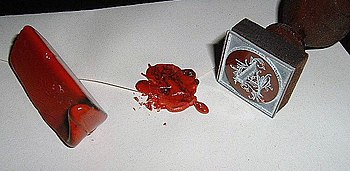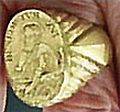seal

The seal (from the Latin sigillum `` little picture '' ) is a form of authentication of documents or assurance (closure) of the intactness of objects or containers (envelope, door) with the help of a seal stamp or, sphragistically (scientifically) correct, a typar that is inserted into a soft, hardening mass is pressed (sealing lumps of sealing wax , wax , early clay, etc.). Often there is no conceptual differentiation between “seal” as an imprint and “seal stamp” as an embossing tool. The Slavic term seal (n.) Can also be used for “seal stamp” .
etymology
The expression seal has been used since the 14th century and is derived from the Middle High German sigel and the Middle Low German seg (g) el . It is borrowed from the Latin sigillum - 'seal imprint', a diminutive of signum - 'sign, mark, image in the seal '.
history
The earliest stamp seals in the Middle East cannot be proven before the Tell Halaf period . Cylinder seals are first found in Sumer between 3200 and 3100 BC. In the Uruk IV layer . These are small stone cylinders ( seal stones ) made of onyx , lapis lazuli , agate or other materials, in which figures and inscriptions have been engraved (seal engraving) . The size varies between 0.15 and 10 centimeters. The characteristic seal impression is created by rolling the cylinder into a soft mass (e.g. clay). Around the same time, between 1600 BC, BC and 1500 BC In ancient Egypt , Ugarit and the Hittites, the signet rings were found, although the signet ring was not in use in Mesopotamia . The Asian seals are cut into hardwood , bone , ivory , marble , soapstone, or jade .
Clay seal impressions can be found with the Sumerians, Assyrians and Babylonians (cylinder seals), later with Greeks and Romans, who took over the rulers of the early Middle Ages. In contrast to the cylindrical cylinder seals of the Babylonians, the Cretans and Hittites used the seal with a round seal.
Even more than in the East (and later Europe), where the seal is always the character of a certification has retained, in East Asia is the seal of unequivocal proof of identity - there represents the seal until today the role of the handwritten signature respectively the signature in the western culture. The significance of the seal is so great that an ancient script of its own has been preserved for it, the seal script (Zhuanshu).
Seals, which have often been symbols of royal or aristocratic power since antiquity, initially indicated individual personalities, then corporations. There were imperial seals in China from the first millennium BC. In Byzantium they had existed since the 6th century, and papal seals since the 9th century. In the early and high Middle Ages, emperors, kings, members of the nobility and the high clergy were sealed in Europe. Citizens have also made use of this type of authentication since around the 13th century. Seals of religious corporations have been found since the 11th century, city seals since the beginning of the 12th century (Trier 1113, Cologne 1149).
Metal seals , the bulls , were made of gold , lead, or (less often) silver . In the Holy Roman Empire, they were mainly reserved for the popes (see Golden Bull of Charles IV ) or the Byzantine emperors for documents of particular political and constitutional importance. Lead bulls were mostly massive, while gold bulls were almost never. Rather, it was a matter of joined gold plates, which were filled with various materials (wax, sawdust, etc.). Solid gold bulls are only known from the Byzantine area and the Norman Kingdom of Sicily.
In the Middle Ages, wax seals carried most documents and legal transactions of all kinds. The seal - ring or stamp - is pressed into sealing wax . The popes as well as the Roman German emperors and subordinate seal leaders differed by colored wax seals with the following ranking:

- red wax : emperors, kings who could also grant the right to other princes, in principle only with (constitutional) “sovereigns”;
- green wax: pens and monasteries ;
- white wax: free imperial cities ;
- black wax: the Patriarch of Jerusalem and the Grand Masters of the religious orders of knights ; still occasionally with funeral letters today.
Sealing wax , which is more heat-resistant than wax , has also been used since the 16th century . Pictorial representations (e.g. coats of arms) have been used in seals since the 11th century. Later, instead of the wax, so-called wafers (round white paper surfaces) were used, which were glued to the paper and then shaped under high pressure with the help of heat (as with embossing ) into a relief, the impression.
The misuse of the seal was prevented by being kept by high officials specially appointed for this purpose, the seal keepers . This task later became an office and a title (see Lord Seal Keeper in England).
Sealed capsules are usually made of wood or metal for seals. In particular in Roman times they were used to protect the seals on documents such as wax tablets.
Sealing pots are small bowls (usually made of metal) that are attached to a container (e.g. a safe ) to hold sealing cords and seals (usually imprints in plasticine ). They serve to identify people who have opened the container and then closed it again.
Forms of seals
Provided with a handle, one is Seal also Petschaft called - are older signet rings . The seal itself can be pressed onto the certificate or through a cut in the parchment . Attached seals are attached to cords made of hemp, silk, other fabrics or strips of parchment. These parchment strips, called pressels , were, like the cords, often pulled through a parchment fold, the plica , in order to increase the hold in the parchment and to prevent tearing.
The most common shape in Europe is the round seal , while the Chinese Yinjian , for example, are rectangular - the Japanese Hanko are also round.
Other embodiments with a sealing function are stickers such as the deposit seal (colloquially also called cuckoo ), the approval sticker attached to vehicle license plates , seals on closures and devices, security stamps on measuring devices, seal stamps and sealing tapes.
Notaries use a sealing cord to connect multi-page documents, the ends of which are secured with an embossed seal made of paper and a wafer .
Special seals and other technical terms
- Cylinder seal - first used in Sumer
- Signet ring -seal stamp housedin the finger ring
- Reitersiegel - represents the seal leader (ladies' seal) on horseback, male seal leader i. d. R. in armor and in arms
- Gem seal - seal with the characteristic imprint of a gem (often in connection with a signet ring), which can be of either ancient or contemporary origin; so used z. B. the early Carolingian kings antique gems to seal their documents.
- Big Seal - the main seal of a corporation that was used to seal the most important documents
- Small seal - for notarizing small, everyday legal transactions; emerged from the secretion seal
- Stamp - official seal to the legally binding marking of documents or for the closure of containers or premises
- Secret seals , also known as secret seals, were stamped in the Middle Ages as a second seal for checking and as a renewed confirmation of authenticity on the back of the main seal or the “Great Seal”. Originally only documents with a secret seal were not legally effective. In the late Middle Ages, however, the secret seal found accepted use in the certification of everyday and relatively unimportant official business and was thus included in the “Small Seal”.
- Back seal - was stamped on the back of the main seal (see secretion seal), not to be confused with the bulls, which are also stamped on both sides
- Coat of arms seal - often shield-shaped seal with the coat of arms of the seal leader, sometimes used as a small seal or back seal
- Rombildsiegel - seal with a pictorial representation of the city of Rome , usually part of the bulls of kings and emperors of the medieval German Empire
- Community seal - joint seal of a legally connected corporation or of several members of a manor house
- Round seal in Austria (corresponds to the round stamp in Germany) - authorities, civil engineers, architects and judicial experts are allowed to use a round seal and thus seal documents, plans, reports, etc.
- Signet - private seal, usually made as a ring
- Seal in the East Asian cultural area : The Chinese name for seal is yín (印) or túzhāng (图章). The Japanese name for seal is Inshō (印章) or Hanko (判 子). The Korean name for seal is dojang (도장). These seals are used for business and private purposes and are often more important than the handwritten signature. In some cases only the seal is accepted as authentication.
Special seals:
- Fischerring - the papal signet ring
In a broader sense:
- Electronic seal -digital information (file) signedusing a cryptic process
Examples of different seals
Seal of the city of Steyr , 1304
Seal of the University of Cologne
Big Bonn city seal
Seal of Emperor Heinrich III.
Back of a bull of Emperor Frederick II from 1246
Seal on letter of nobility from Emperor Charles VI.
Seal of the Kayser Steinbruch , from 1617
Seal of Johann III. of Straubing-Holland (1422)
Seal of the Grand Master of the Teutonic Order
Red wax seal of the city of Bozen from 1488
Adhesive seal: tax stamp on a pack of cigarettes
Fishing ring from Pope Benedict XVI.
Seal of the Ludwig Maximilians University in Munich .
Seal of the Imperial Navy - Office for the troops in Helgoland
Seal of the Baden-Württemberg police at a crime scene
Seal in the private / civil area
Sealing stamps and types for use with sealing wax (seals, seal rings, etc.) are only required in the private / civil sector by various postal services for the dispatch of value items ( value letters or parcels) to seal the item (in Germany until 2010).
There is usually no regulation for the design of the typefaces, and imprints of coins and buttons are generally not permitted.
Otherwise seals are mostly only used for the stylish design of honorary certificates and private correspondence.
A private sealing seal (also a seal or seal mark ) on a container or on a “ scaled ” document, including a document connected with eyelets, thread and seal, indicates that the issuer does not want the document to be manipulated and that it is in the present form was created once.
Legal
Legally, every official "seal" is unique (compared to any " stamp " that can be produced at will - it behaves in a similar way to the difference between flag and flag ). Who is allowed to run it is specifically regulated. The breaking of a seal , the unauthorized destruction of a seal that has been affixed by an authority, a public official or otherwise on an official basis, is punishable in Germany ( Section 136 (2 ) StGB ). Likewise, it is not permitted to use a stamp that can be confused with the seal of a public official or an authority. A seal stamp of an authority that has become unusable may only be destroyed with the assistance of a witness and with an appropriate protocol. The decommissioning of seal stamps is published in the respective official gazettes. For this purpose, seals have a unique number.
See also
- Book with seven seals - the symbols in the Bible
- Historical auxiliary sciences
- manu propria - the handwritten signature of a ruler
- Sphragis - encrypted references to the author in a literary work
- Tibetan seal
- Documents of the Middle Ages and the Early Modern Age
- Seal of Muhammad
- Plica (parchment)
- Shed of documents
- seal of approval
literature
Manuals:
- Toni Diederich : Rheinische Städtesiegel (= Rheinischer Verein für Denkmalpflege und Heimatschutz, yearbook 1984/85 ). Neuss 1984, ISBN 3-88094-481-4 .
- Toni Diederich: Siegelkunde: Contributions to their deepening and continuation . Cologne 2012, ISBN 978-3-412-20956-8 .
- Wilhelm Ewald : Siegelkunde (= Georg von Below, Friedrich Meinecke [Hrsg.]: Handbook of medieval and modern history . Volume 4 ). R. Oldenbourg, Munich / Berlin 1914 ( archive.org - reprint Munich 1978).
- Erich Kittel : Siegel (= library for friends of art and antiques . Volume 11 ). Braunschweig 1970 (with extensive bibliography, pp. 468–509).
- Michel Pastoureau: Les sceaux (= Typology des sources du moyen âge occidental . Volume 36 ). 1981, ISSN 0775-3381 .
- Andrea Stieldorf : Siegelkunde (= Hahnsche historical auxiliary sciences . Volume 1 ). Hanover 2004, ISBN 3-7752-6132-X .
- The seal. Use and meaning . Edited by Gabriela Signori. Darmstadt 2007 ISBN 978-3-534-20682-7
Table works:
- Wilhelm Ewald: Rheinische Siegel (= publications of the Society for Rheinische Geschichtskunde . Volume 27 ). Bonn (6 volumes, 1906–1941).
- Aldo Martini: The gold seal collection from the secret archive of the Vatican: Catalog of the exhibition in the Bayerische Landesbank Munich . 1989 (no location).
- Friedrich Philippi : Seal (= certificates and seals in replicas . Volume 4 ). Berlin 1914.
-
Otto Posse : The seals of the German kings and emperors from 751–1913 . Dresden ( Wikisource - 5 volumes, 1909–1913).
- Volume 1: 751-1347. From Pippin to Ludwig the Bavarian.
- Volume 2: 1347-1493. From Karl IV to Friedrich III. Medieval forgery genes. Seal of Peace.
- Volume 3: 1493-1711. From Maximilian I to Josef I.
- Volume 4: 1711-1806, 1871-1913. From Karl VI to Franz II, Wilhelm I to Wilhelm II. Reichsvikariat, Reichskammergericht. Electors College, Supplements.
- Volume 5: The seal system of the German emperors and kings, from 751 to 1913. (Text volume)
- Pietro Sella: I sigilli dell'Archivio Segreto Vaticano (= Inventari dell'Archivio Segreto Vaticano . Volume 1-3 ). Vatican (1937, 1946, 1964).
Resources and bibliography:
- Eckart Henning, Gabriele Jochums: Bibliography for Sphragistics. Literature from Germany, Austria and Switzerland until 1990 (= Bibliography of the historical auxiliary sciences . Volume 2 ). Cologne 1995, ISBN 3-412-08695-9 .
- Vocabulaire international de la sigillographie (= Pubblicazioni degli Archivi di Stato, Sussidi . Volume 3 ). Rome 1990.
Web links
- Sealing / Sphragistics Section Virtual Library Historical auxiliary sciences
- Open access image database of the separate seal images in the photo archive of older original documents , via Prometheus image archive with almost 5,000 seal images
- Wolfgang Krauth: Seal. In: Südwestdeutsche Archivalienkunde.
Individual evidence
- ^ Friedrich Kluge: Etymological dictionary. de Gruyter, Berlin / New York 1995, ISBN 3-11-012922-1 .
- ^ Egon Friedell : Cultural history of antiquity . Cultural history of Egypt and the ancient Orient . Munich: dtv 1982.
- ↑ Decision of the Administrative Court
- ↑ round seal on www.gerichts-sv.at
- ↑ Professional oath / seal / ZT ID card at wien.arching.at , the shape of the seal has now been released. The term “round seal” is still used.





















